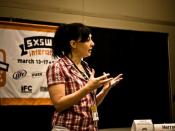Cultural Communication and the Disabled.
Dawn O. Braithwaite and Charles A. Braithwaite's "Understanding Communication of Persons with disabilities as Cultural Communication" makes a point that what ordinary people take for granted cannot be taken for granted by the disabled, and that this makes for difficulties in communication between them. Except for people who have been disabled from birth, becoming disabled involves learning new ways of relating to people and talking about oneself and one's needs. Communication may be affected by disability as much as it affects mobility, employment, self-care and social relationships. The emphasis on physical attractiveness in Western culture may distort one's relationships with the disabled, and seemingly harmless remarks can be taken to have negative connotations. Research in the field is hampered by a lack of material dealing directly with disabled people as individuals rather than as case studies, and existing research is done from the point of view of the able bodied.
Linda A. Siple's "Cultural Patterns of Deaf People" examines deafness in terms of its creating a distinct culture, evinced in different body language, signs, beliefs, and values. Deafness affects how one perceives the world. A greater dependence is found on vision and touch, and the deaf person places more value on direct and face to face communication. Directness and openness is valued more by the deaf. There is also a sense of pride found in the deaf, so strong that cochlear transplants that may cure deafness may be feared by them.
Language is found to be fully developed among the deaf, and A S L (American Sign Language) is now taken as a distinct language in its own right. The use of euphemisms is avoided, and visual signs and symbols are used to replace aural ones. Separate signs may be used for individuals...


